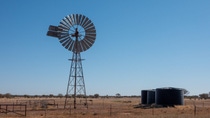Plastic water tanks survive and enable survival in the Australian outback

BASF light stabilisers provide long-lasting protection to polyethylene water storage tanks against strong UV radiation in the Australian outback, thereby, extending the life of the polymer compound.
The Australian outback is one of the hottest and driest places on earth. In rural and remote towns, fresh water is a limited and valuable commodity. Living and surviving under such severe climatic conditions depends on the use of water collected in plastic water tanks. But, wouldn’t the harsh Australian sun be too much for water tanks made of polyethylene (PE) to handle?
“Not if they are UV stabilised,” said Hermann Althoff, BASF’s Senior Vice President, Performance Chemicals Asia Pacific. “It is common knowledge that PE degrades when exposed to UV radiation from the sun. Over time, the surface chalks and cracks, and the polymer becomes brittle, as its structural integrity is compromised. For this application, we recommend Irgastab® IS 2580 and Irgastab® IS 2515, our fully formulated solutions for roto-molding PE grades. It helps to maintain the integrity of polymer properties during processing and provides long-term durability to the water tanks by preventing degradation from UV rays, thermal stress and oxidation.”
BASF’s plastic additives have been adopted by many customers in Australia to make rotationally-molded, linear, low-density polyethylene (LLDPE) water storage tanks. In the case of plastic water tanks, excellent physical performance is of little value, unless the product is tough enough to maintain its long-term performance under the sun.
Parts of Australia have a very high UV Index (an international standard measurement of the strength of UV radiation). Peak daily values in summer are regularly over 12-14 and can even reach 16-17 at more northern latitudes. As a reference, the World Health Organisation warns against spending time outside when the UV index tops 10, which is considered extreme, where exposure to direct sunlight for 15 minutes can cause sunburn.
Now, imagine a plastic water tank positioned outside every day under such extreme UV levels. Over time, UV exposure to inadequately stabilised water tanks can result in the weathering of polyethylene tanks. Traditionally a UV8 level of stabilisation has been considered the minimum required for long-term protection. However, to withstand the demands of daily use in Australia, UV20 is the required “longer-term” protection.
“It’s clear that using the right additives can improve the lifetime of PE tanks in extreme weather conditions. By extending the durability, customers can also reduce plastic waste and ultimately costs by replacing their tanks less frequently. Ensuring that water isn’t lost due to tank failure and leakage in severe drought conditions helps reduce the growing concern for human and environmental health,” said Dr. Marina Leed, Global Sustainability Manager for Plastic Additives.
In addition to improving technical performance of the tanks, Irgastab® products also have other significant contributions to a sustainable future. During the roto-molding process, Irgastab® reduces energy consumption by enabling shorter processing times and lower molding temperatures. This further increases the service life of the molded product.